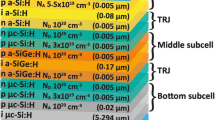Abstract
In this work, the temperature effects on the PV’s electrical and optical parameters of different surface gratings are studied. A 3D simulation is introduced for studying the PV’s electrical parameters such as short circuit current, open-circuit voltage, and efficiency at different levels of temperature with and without surface’s gratings. We observed that the efficiency is increased for PV of surface grating by about 4.87% compared to the free grating surface’s PV. The efficiency of the PV efficiency is degraded when the temperature is increased above 300 K. The solar cell efficiency of gratings free is aggressively degraded compared to the solar cell that includes gratings by about 4.89% at 360 K. The electrical parameters such as the open-circuit voltage and short circuit current are enhanced compared to the PV of surface grating free. Also, we observed that the triangle grating geometry of dimensions about 10 × 10 nm produced a higher efficiency compared to the other PV of other grating geometries of the same dimensions.










Similar content being viewed by others
Data availability
Data related to this article are available from the corresponding author upon reasonable request.
References
Abdelhamid, H., Edris, A., Helmy, A., Ismail, Y.: Fast and accurate PV model for SPICE simulation. J. Comput. Elect. 2(18), 260–270 (2019)
Battaglia, C., et al.: Light trapping in solar cells: can periodic beat random? ACS Nano 6(3), 2790–2797 (2012)
Contreras, M.A., Nakada, T., Pudov, A.O., Sites, R.: ZnO/ZnS(O,OH)/Cu(In,Ga)Se2/ Mo solar cell with 18.6% efficiency. In: Proceedings of the Third World Conference of Photovoltaic Energy Conversion, pp. 570–573 (2003)
Elewa, S., Yousif, B., Abo-Elsoud, M.E.A.: Efficiency enhancement of intermediate band solar cell using front surface pyramid grating. Opt. Quant. Electron 53, 360 (2021). https://doi.org/10.1007/s11082-021-03007-6
ElKhamisy, K., Abdelhamid, H., Elagooz, S., et al.: The effect of different surface plasmon polariton shapes on thin-film solar cell efficiency. J. Comput. Elect. (2021). https://doi.org/10.1007/s10825-021-01729-0
ElKhamisy, K.M., El-Rabaie, S., Elagooz, S.S., Elhamid, H.A.: The effect of different surface grating shapes on thin film solar cell efficiency. International Conference on Innovative Trends in Computer Engineering (ITCE), Aswan, Egypt (2019).
Evoy, A.M.C., Markvart, T., Castaner, L.: Practical Handbook of Photovoltaics Fundamentals and Applications, 2nd edn. Elsevier, Hoboken (2012)
Fan, J.C.C.: Theoretical temperature dependence of solar cell parameters. Solar Cells 17, 309–315 (1986)
Fonash, S., (Ed): Homojunction solar cells. In: Solar Cell Device Physics, pp. 155–166, Elsevier, Burlington, Massachusetts (2012).
Friedman, D.J.: Modeling of tandem cell temperature coefficients. In: Proceedings of the 25th IEEE Photovoltaic Specialists Conference, Washington DC, IEEE, New York, pp. 89–92 (1996)
Ghahremani, A., Fathy, A.E.: A three-dimensional multiphysics modeling of thin-film amorphous silicon solar cells. Energy Sci. Eng. 3(6), 520–534 (2015). https://doi.org/10.1002/ese3.100
Hall, R.N.: Electron-hole recombination in silicon. Phys. Rev. 87, 387 (1952)
Jeng, M.J., Lee, Y.L., Chang, L.B.: Temperature dependences of lnxGa1xN multiple quantum well solar cells. J. Phys. D Appl. Phys. 42, 105101 (2009)
Khalifa, A.E., Elhamid, H.A., Swillam, M.A.: Optimal design of intermediate reflector layer in micromorph silicon thin-film solar cells. J. Nanophoton. 4(10), 046006–1 (2016)
Landis, G., Rafaelle, R., Merritt, D.: High temperature solar cell development. In: Proceedings of the 19th European Photovoltaic Science and Engineering Conference, Paris, France, June 7–11 (2004)
Madelung, O.: Semiconductors: data handbook. Springer, Berlin Heidelberg (2004)
Pässler, R.: Parameter sets due to fittings of the temperature dependencies of fundamental bandgaps in semiconductors. Phys. Stat. Sol. (b) 216(2), 975–1007 (1999)
Salem, M., Zekry, A., Shaker, A.: Investigation of base high doping impact on the npn solar cell microstructure performance using physically based analytical model. IEEE ACCESS 9, 16958–16966 (2021)
Singh, J.: Electronic and Optoelectronic Properties of Semiconductor Structures, 1st edn. Cambridge University Press, Cambridge; New York (2007)
Singh, P., Singh, S.N., Lal, M., Husain, M.: Temperature dependence of I-V characteristics and performance parameters of silicon solar cell. Solar Energy Mater. Solar Cells 92, 1611–1616 (2008)
Staebler, D., Wronski, C.R.: Optically induced conductivity changes in dischargeproduced hydrogenated amorphous silicon. J. Appl. Phys. 51(6), 3262–3268 (1980)
Sze, S.M.: Physics of Semiconductor Devices, p. 264. Wiley, New York (1981)
Wang, K.X., et al.: Absorption enhancement in ultrathin crystalline silicon solar cells with antireflection and light-trapping nanocone gratings. Nano Lett. 12(3), 1616–1619 (2012)
Wang, J., Xu, Z., Bian, F., Wang, H., Wang, J.: Design and analysis of light trapping in thin-film gallium arsenide solar cells using an efficient hybrid nanostructure. J. Nanophoton. 11(4), 046017 (2017). https://doi.org/10.1117/1.JNP.11.046017
Wysocki, J.J., Rappaport, P.: Effect of temperature on photovoltaic solar energy conversion. J. Appl. Phys. 31, 571–578 (1960)
Yousif, B., Abo-Elsoud, M.E.A., Marouf, H.: Triangle grating for enhancement the efficiency in thin film photovoltaic solar cells. Opt. Quant. Electron. 51, 276 (2019)
Zeng, L., et al.: Demonstration of enhanced absorption in thin-film Si solar cells with textured photonic crystal back reflector. Appl. Phys. Lett. 93(22), 221105 (2008)
Funding
No funding was received.
Author information
Authors and Affiliations
Contributions
All the authors have contributed equally.
Corresponding author
Ethics declarations
Conflict of interest
The authors declare that they have no conflict of interest.
Consent to participate
All the authors agreed to involve in this research work.
Consent for publication
All the authors have given permission to publish the results.
Additional information
Publisher's Note
Springer Nature remains neutral with regard to jurisdictional claims in published maps and institutional affiliations.
Rights and permissions
About this article
Cite this article
ElKhamisy, K., Abdelhamid, H., Elagooz, S. et al. The efficiency of silicon thin film solar cell: impact of temperature with different surface shapes. Opt Quant Electron 54, 49 (2022). https://doi.org/10.1007/s11082-021-03433-6
Received:
Accepted:
Published:
DOI: https://doi.org/10.1007/s11082-021-03433-6




